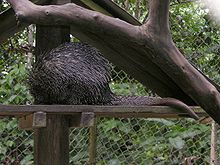
Porcupines are large rodents with coats of sharp spines, or quills, that protect them against predation. The term covers two families of animals: the Old World porcupines of family Hystricidae, and the New World porcupines of family Erethizontidae. Both families belong to the infraorder Hystricognathi within the profoundly diverse order Rodentia and display superficially similar coats of rigid or semi-rigid quills, which are modified hairs composed of keratin. Despite this, the two groups are distinct from one another and are not closely related to each other within the Hystricognathi. The largest species of porcupine is the third-largest living rodent in the world, after the capybara and beaver.

The New World porcupines, family Erethizontidae, are large arboreal rodents, distinguished by their spiny coverings from which they take their name. They inhabit forests and wooded regions across North America, and into northern South America. Although both the New World and Old World porcupine families belong to the Hystricognathi branch of the vast order Rodentia, they are quite different and are not closely related.
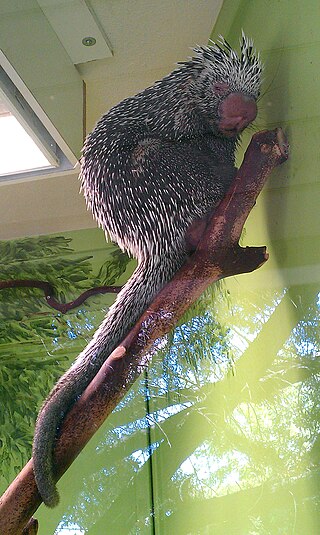
The Brazilian porcupine is a porcupine found in Brazil, Argentina, Colombia, Venezuela, Guyana, French Guiana, Peru, Paraguay, Suriname, Bolivia and Trinidad, with a single record from Ecuador. It inhabits tropical forests at elevations up to 1500 m.
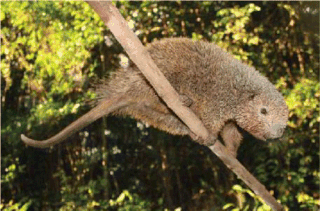
The bristle-spined rat is an arboreal rodent from the Atlantic forest in eastern Brazil. Also known as the bristle-spined porcupine or thin-spined porcupine, it is the only member of the genus Chaetomys and the subfamily Chaetomyinae. It was officially described in 1818, but rarely sighted since, until December 1986, when two specimens - one a pregnant female - were found in the vicinity of Valencia in Bahia. Since then it has been recorded at several localities in eastern Brazil, from Sergipe to Espírito Santo, but it remains rare and threatened due to habitat loss, poaching and roadkills.

The prehensile-tailed porcupines or coendous are found in Central and South America. Two other formerly recognized Neotropical tree porcupine genera, Echinoprocta and Sphiggurus, have been subsumed into Coendou, since Sphiggurus was shown by genetic studies to be polyphyletic, while Echinoprocta nested within Coendou.
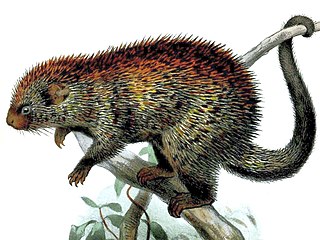
The Paraguaian hairy dwarf porcupine is a porcupine species from the family Erethizontidae. It is found in Argentina, Brazil, Paraguay and Uruguay.

The black-tailed hairy dwarf porcupine is a porcupine species from the family Erethizontidae. It is found in Brazil, Colombia, Ecuador, French Guiana, Guyana, Suriname and Venezuela.
Roosmalen's dwarf porcupine is a porcupine species from the New World porcupine family likely endemic to northern Brazil. Only three specimens were known at the time, and only one had a collection locality. It is named for Marc van Roosmalen and his son Tomas, whose collections from the middle Madeira included the first known specimens. It was soon assigned to the genus Sphiggurus, although this genus was not recognized by the authors. Genetic studies in 2013 have since showed Sphiggurus to be polyphyletic. Nonetheless it is commonly classified as Sphiggurus roosmalenorum. Coendou roosmalenorum may be misspelled due to a conflicting basionym combination.

The dwarf fat-tailed mouse opossum, also known as the velvety fat-tailed opossum is an opossum species from South America. It is endemic to Brazil, where it is found in cerrado and caatinga habitats. Its head-and-body length is about 141-212 mm, and its tail length is about 73-85 mm. Its diet is 44% arthropods; 75% of its diet consists of animals and animal products. Its ventral fur is entirely gray-based. Its hind foot is less than 14 mm, which is short for the genus.

The long-tailed spiny rat is a spiny rat species found in Bolivia, Brazil and Paraguay.

Bennett's chinchilla rat is a species of chinchilla rat in the family Abrocomidae. It is found only in Chile where its habitat is Mediterranean-type scrub on the western side of the Andes. The IUCN has assessed its conservation status as being of "least concern".

The bicolored hawk is a species of bird of prey in the family Accipitridae. It is found in forest, woodland, second growth, plantations, and wooded savanna in southeastern Mexico, Central America, and northern and central South America. Though generally uncommon, it is the most common species of Accipiter in most of its range, but it does not occur at altitudes above 2,700 metres (8,900 ft) such as the highest parts of the Andes.

The Paraguayan fat-tailed mouse opossum is a species of opossum in the family Didelphidae. It is found in forested areas of Brazil and Paraguay. It is known only from a few specimens. For two listed specimens, one had a head-and-body length of about 135 mm and a tail length of about 140 mm, while the other had a head-and-body length of about 120 mm and a tail length of about 155 mm. Most of its fur is gray, but the shoulder areas are reddish gray, and the ventral fur is pure white or creamy white. There is also a ring of black fur surrounding each eye. The ventral surface of the tail is white. The dorsal surface of the tail is gray for the first one third to one half of its length ; the remainder of the dorsal surface of the tail is white. The tail is hairless except for about its first ten mm. Although the genus Thylamys is characterized by fat storage in the tail, there is no evidence that this species stores fat in its tail.
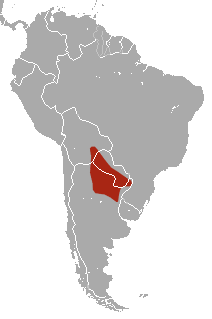
The common fat-tailed mouse opossum is a species of opossum in the family Didelphidae. It occurs in Argentina, Bolivia, Brazil, and Paraguay in chaco and Andean foothill habitats. Its head-and-body length is about 75 to 120 mm, and its tail length is about 90 to 134 mm. Its dorsal fur is brownish gray, and its ventral fur is yellowish to white. The legs and cheeks are the same color as the ventral surface. Its tail is sharply bicolored. A ring of faintly darker fur surrounds each eye. Its tail often lacks fat deposits, but does not always.

Emily's tuco-tuco is a species of rodent in the family Ctenomyidae. It is endemic to Argentina.

The robust tuco-tuco is a species of rodent in the family Ctenomyidae. It is a burrowing rodent and is endemic to the Tucumán Province of Argentina.

The stump-tailed porcupine is a species of rodent in the family Erethizontidae. It is found mainly in Colombia, with a few records from Ecuador.
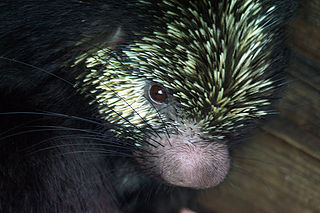
The Mexican hairy dwarf porcupine or Mexican tree porcupine is a species of rodent in the family Erethizontidae. It is found in Costa Rica, El Salvador, Guatemala, Honduras, Panama, Mexico, Nicaragua and Belize.

Karimi's fat-tailed mouse opossum is a species of opossum in the family Didelphidae. It is endemic to central and northeast Brazil, where it is found in the cerrado and caatinga at elevations from 300 to 1100 m. This opossum is crepuscular and mostly terrestrial; its omnivorous diet includes leaves, insects and small vertebrates. Its head-and-body length is about 95 millimeters, and its tail length is about 72 millimeters. It is very similar to T. pallidor. Its tail may be nonprehensile. The species is named after Iranian epidemiologist Y. Karimi. It is threatened by habitat destruction and fragmentation due to agriculture and ranching.

The Andean porcupine or Quichua porcupine is a species of rodent in the family Erethizontidae. It is found in the Andes of northern Ecuador and Colombia as well as in Panama. This porcupine is little known, but is probably arboreal, nocturnal and solitary like its relatives. The species is thought to be uncommon to rare and the population decreasing. It is threatened by deforestation, habitat fragmentation and agriculture.
